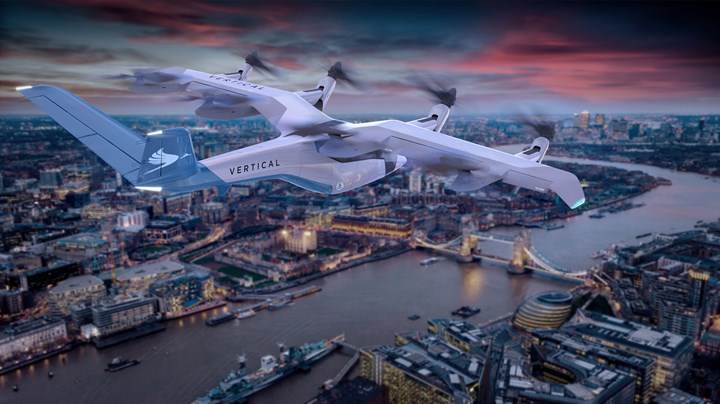Solvay, Vertical Aerospace expand on UAM agreement
Composite materials supplier Solvay Composite Materials and urban air mobility (UAM) manufacturer Vertical Aerospace offer details about materials, process use in VA-1X aircraft.

Rendering of Vertical Aerospace’s VA-1X in flight. Photo Credit: Vertical Aerospace
Solvay Composite Materials (Alpharetta, Ga., U.S.) and urban air mobility (UAM) aircraft manufacturer (VA, Bristol, U.K.) previously announced in early February an agreement to collaborate on the development and manufacture of Vertical Aerospace’s VA-1X electric vertical take-off and landing (eVTOL) aircraft. Under the agreement, Solvay will provide access to its portfolio of composite materials, including resin systems, prepregs and adhesives. CW spoke recently with Solvay representatives and Michael Cervenka, CEO of VA, to learn more about the collaboration.
VA was founded in 2016 by Stephen Fitzpatrick, who had previously founded the Manor F1 racing team. Cervenka says Fitzpatrick has a strong sustainability vision and seeks to decarbonize air travel. For the first three years of its existence, VA operated in “stealth” mode, developing early eVTOL designs and test flying several prototypes. In 2020, says Cervenka, VA formally introduced the VA-1X, a piloted, four-passenger all-electric tiltrotor aircraft with a range of 160 kilometers/100 miles and a cruise speed of 240 kph/150 mph. The first flying prototype of the VA-1X is expected in September 2021, with entry into service in 2024.
Cervenka says Solvay was chosen as a partner because of the material supplier’s robust array of product solutions, shared values and strong U.K. presence. In addition, he notes that VA was looking for assistance with process development, particularly getting to rate. Further, Cervenka says VA is paying close attention to weight management on the VA-1X; Solvay is expected to help with that effort.
Gérald Perrin, program director - automotive at Solvay, says the eventual pace of manufacture for the UAM market in general, and for VA in particular, demands a mix of proven/qualified aerospace-grade materials combined with manufacturing processes that meet the demands of a high-volume environment. “It really is a mix of aerospace and automotive,” he says.
Sam Hill, EMEA customer engineering manager at Solvay, reports that Solvay’s MTM45-1 toughed epoxy prepreg will be deployed for the VA-1X, chosen because it is highly and widely qualified and offers flexibility for use in or out of the autoclave. Other material types Solvay expects to provide include tooling prepregs, surfacing materials, lightning strike materials and adhesives. “We are aligning Solvay’s full material portfolio to meet the needs of this program. We will also be utilizing Solvay’s customer engineering support model with access to our state-of-the-art application centers and onsite technical support via our network of engineering specialist,” Hill says. “This is a very important opportunity for the company.”
Cervenka says prototype aerostructures for the VA-1X will be fabricated by already identified suppliers, with assembly done by VA. Cervenka says VA expects to produce about 100 aircraft in low-rate production, with rapid ramp up to larger totals — “quickly reaching low thousands” — at full rate. When that happens, composites fabrication will be allocated to a Tier 1 fabricator. Along the way, Cervenka and Hill say they expect materials and process selection will evolve to potentially integrate more out-of-autoclave options — such as thermoplastics — and automation such as automated fiber placement (AFP). VA is using the Dassault Systèmes (Waltham, Mass., U.S.) 3DEXPERIENCE suite of design software to optimize design engineering on the VA-1X.
Although Cervenka is philosophical about the UAM market and recognizes that VA has much to learn, he also knows that the VA-1X represents a novel type of flying vehicle that demands much of the OEM: “The VA-1X must be 100 times safer than a helicopter, quieter than a helicopter, have no single point of failure, be less expensive to operate, have lower maintenance costs, possess significant redundancies, and be emissions free. That’s a challenge.”
Still, he says the potential of the UAM market is too big to ignore: “None of us has a crystal ball to see how big this market will be, and how quickly. Our aim is to leverage our early mover status and come to market with a highly competitive fully commercially viable aircraft quickly.” VA plans to achieve flight certification in Europe first, followed by the VA-1X entering service in cities and regions that are “geographically challenged” and thus stand to benefit from the point-to-point ridesharing service that UAM vehicles are designed to provide.
Once that model is established, and assuming public acceptance follows, Cervenka expects the VA-1X will be deployed in other large cities with poor or challenged road infrastructure. He says that by 2030 there will be “many major cities throughout the world served by large UAM fleets.” Like other new technologies, Cervenka says UAM aircraft will initially provide a premium service, but over that the next decade it will become democratized and more affordable to more people. VA’s cost target for the VA-1X and its successors is less than $3.00 per passenger mile.
Finally, there is one technology on the VA-1X that the company will hold very close: the batteries. “There is no off-the-shelf battery system for this application,” Cervenka notes. “It’s very important that we do this work ourselves.” So, battery development and manufacture for the VA-1X will be fully vertically integrated for the foreseeable future. “We don’t see any killer batteries coming along that disrupt this market,” he contends. “It will be highly incremental.”
Related Content
Composites end markets: Sports and recreation (2025)
The use of composite materials in high-performance sporting goods continues to grow, with new advancements including thermoplastic and sustainability-focused materials and automated processes.
Read MoreTrends fueling the composites recycling movement
Various recycling methods are being considered for composites, from novel dismantling and processing, to building capacity and demonstrating secondary use applications.
Read MoreBio-based, fire-resistant composites become mainstream
Projects use Duplicor prepreg panels with highest Euroclass B fire performance without fire retardants for reduced weight, CO2 footprint in sustainable yet affordable roofs, high-rise façades and modular housing.
Read MoreWatch: A practical view of sustainability in composites product development
Markus Beer of Forward Engineering addresses definitions of sustainability, how to approach sustainability goals, the role of life cycle analysis (LCA) and social, environmental and governmental driving forces. Watch his “CW Tech Days: Sustainability” presentation.
Read MoreRead Next
Cutting 100 pounds, certification time for the X-59 nose cone
Swift Engineering used HyperX software to remove 100 pounds from 38-foot graphite/epoxy cored nose cone for X-59 supersonic aircraft.
Read MoreNext-gen fan blades: Hybrid twin RTM, printed sensors, laser shock disassembly
MORPHO project demonstrates blade with 20% faster RTM cure cycle, uses AI-based monitoring for improved maintenance/life cycle management and proves laser shock disassembly for recycling.
Read MoreUltrasonic welding for in-space manufacturing of CFRTP
Agile Ultrasonics and NASA trial robotic-compatible carbon fiber-reinforced thermoplastic ultrasonic welding technology for space structures.
Read More












